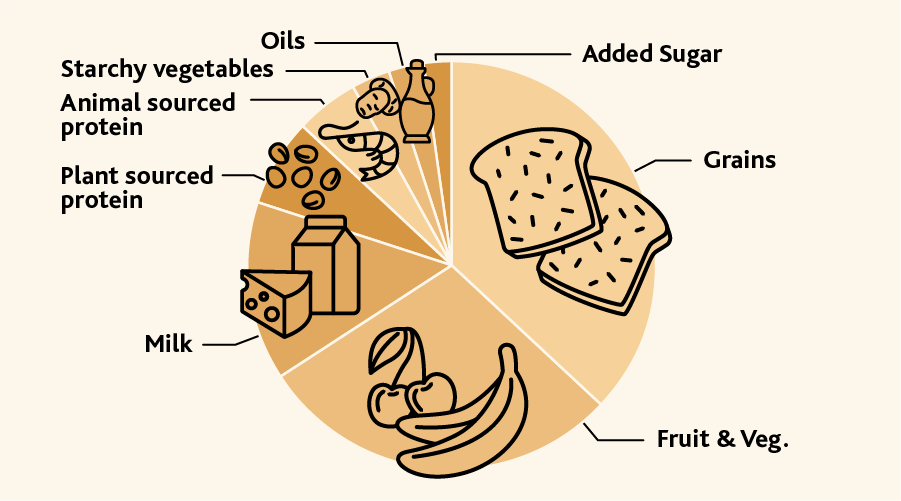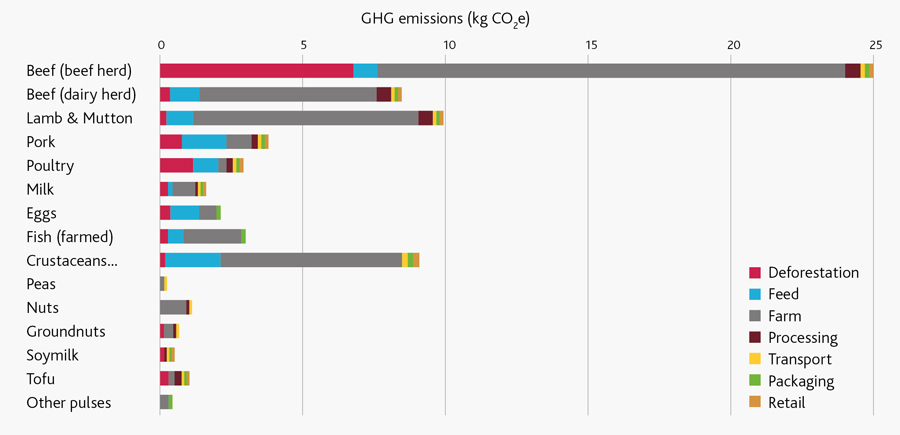Do you know that the production of food produces CO2? Different foods produce different amounts of CO2. This article compares different types of food and suggests how all over the world, people could choose a more healthy diet that also produces less CO2 and therefore helps to tackle the Climate Emergency.
Producing food and getting it to the consumer is high among the major sources of carbon pollution. Mike Berners-Lee, author of the book “There is no Planet B” says that by his analysis a few years ago food production accounted for 20% of greenhouse gases. A more recent analysis reckons that food accounts for about a quarter of greenhouse gases.
With a view to quantifying where the pressure needs to be put to change this, a “diet” has been compiled by The EAT Lancet Commission. This involved 37 leading scientists from 16 countries in various disciplines including human health, agriculture, political sciences and environmental sustainability, to develop global scientific targets for healthy diets and sustainable food production. It is the first attempt to set universal scientific targets for the food system that apply to all people and the planet. A practical example of the weekly diet is pictured below giving percentages by weight of different foods.

| Food type | Percentage | Example |
|---|---|---|
| Fruit & Veg | 29% of diet | 11 portions of fruit + 14 portions of veg |
| Added sugar | 0 to 2% of diet | Up to 0.2kg |
| Oils | 3% of diet (approx 80% unsaturated) | Eg olive oil, 0.4litres |
| Grains | 37% of diet | 15 slices of bread + 5 portions of cooked rice + 8 portions of cooked pasta + 7 portions of cereal or porridge |
| Strachy vegetables | 3% of diet | 7 small potatoes (0.35kg) |
| Milk or equivalent | 14% of diet | 3 pints or 0.17kg of cheese |
| Animal sourced protein | 4.8% of diet | 1 or 2 eggs + 0.2kg fish + 0.2kg chicken + 0.1kg other meat |
| Plant sourced protein | 7.2% of diet | 14 handfuls of nuts (0.35kg) + 0.5g legumes (eg peas, lentils, beans, etc) |
Notice that plant sourced protein is a higher % of the diet than animal sourced protein.
The impact of beef as a food source is glaringly obvious. To obtain the typical daily protein requirement of just 50 grams (about 2oz) from beef, the equivalent of a massive climate-wrecking 25kg (55lbs) of greenhouse gases (equal to about 75 miles in a petrol car) are released. Dairy, lamb and farmed crustaceans are pretty bad too. Notice that all of these have a large contribution labelled “farm” (in grey). For sheep and cattle, this is mostly due to the methane they emit as burps and farts, which because it is 28 times more damaging per kg than CO2, creates the high CO2 equivalent. At the other end of the scale, legumes and nuts release just 1kg CO2 or less, so it’s easy to see why the EAT diet prefers these protein sources. They are healthier too since they contain less saturated fat.
Below is a picture of the carbon pollution, in kilograms of CO2 equivalent, that are released in the process of providing a mere 50 grams (about 2 ounces) of protein.

Graph courtesy of Mike Berners-Lee, data from Poore, J. & Nemecek, T. Reducing food ’ s environmental impacts through producers and consumers. 992, 987–992 (2018)
Berners-Lee reckons that the world’s grown food equates to 5940 calories per person per day. He also estimates that 1740 calories (30%) of this is fed to animals and in addition, they consume 3810 calories from pasture bringing their total calorie consumption to 5550 per day. In return they only supply 590 calories for human consumption, so animals are only 11% efficient at creating food for us with most of their calorie intake spent keeping themselves warm, moving about etc.
As a result, 77% of the world’s farmland is feeding animals to produce just 24% of human daily food requirement. Even so, at first sight the 3810 calories from pasture appears not to be a problem because humans cannot digest grass, but the conversion of forest to pasture is releasing huge amounts of greenhouse gases which contribute significantly to the ongoing Climate Emergency. Just look at what is happening in Brazil, where farming interests are ripping out the world’s greatest “green lung” to farm cattle or grow soya to feed cattle. In the UK we cleared our forests to make pasture centuries ago and we should now be converting pasture to forest and peat to compensate.
So, now you know what kind of diet can help reduce global warming, perhaps you might sit down and note the foods that you eat at the moment. Could you change your eating habits to become closer to the EAT Lancet diet above? What are the implications of eating less beef and lamb in the UK? How might farmers change what they grow?
Download PDF
If you wish to save, or print, this article please use this pdf version »


